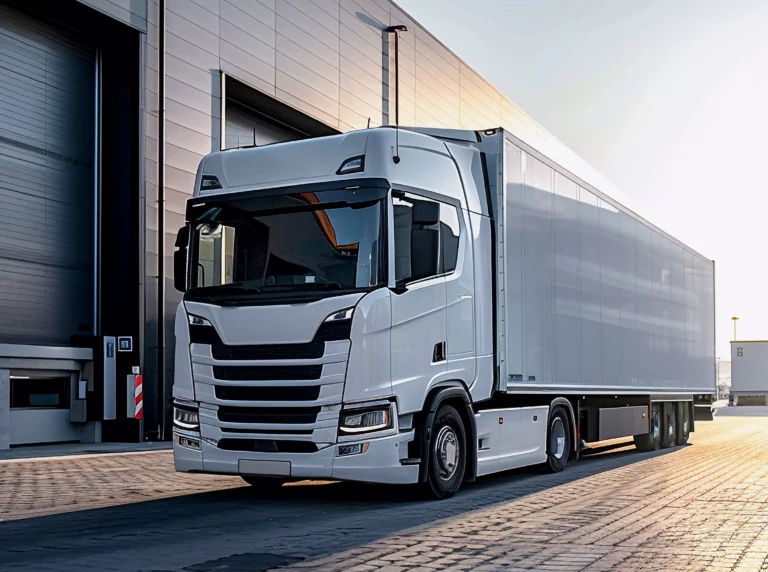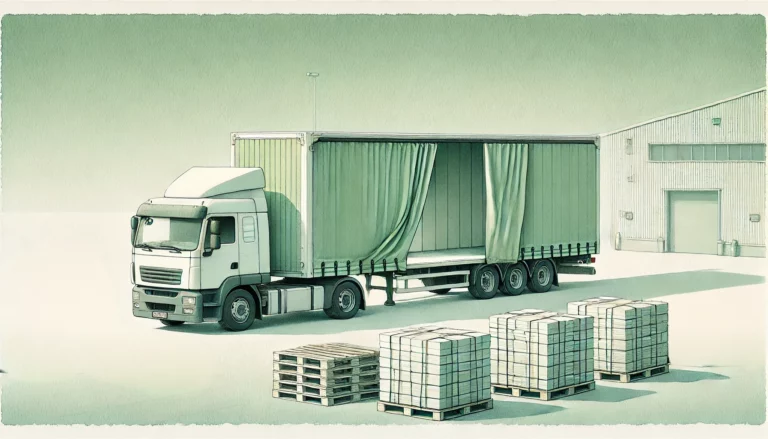Closed loop economy - the role of waste transport

The closed-loop economy focuses on minimising waste through reuse, recycling and closing the life cycle of products. A key element of this concept is the efficient transport of waste. It allows waste to be seamlessly transformed into raw materials and put back into circulation. How else does it support it? We invite you to read the article.
The circular economy - basic information
What it is
The circular economy is a model that differs markedly from the traditional linear economy. Instead of a 'take, use, throw away' process, it focuses on preserving the value of raw materials, products and materials in the economy for as long as possible. This means that the waste of one process becomes the raw material for the next. This reduces the need to extract new raw materials and products are designed so that they can be easily repaired, dismantled and reused.
Objectives and principles
GOZ aims to reduce waste, reduce the consumption of natural resources and minimise environmental impact. The main principles of this model include designing for sustainability, recycling and minimising waste. In practice, this means investing in new technologies, changes in production processes and extensive cooperation between different sectors of the economy.
Closed loop economy - the role of transport
Importance of waste transport for closing the material cycle
Waste transport is a key element in closing the material cycle in a circular economy. Waste that needs to be transported to appropriate recycling or reprocessing facilities is a raw material that can be fed back into the production cycle. Improving transport allows waste to be processed faster and more efficiently, which is essential to keep processes in the GOZ running smoothly.
A way to reduce emissions and costs
Transport route planning plays a key role in reducing greenhouse gas emissions and operating costs. Reducing the distance travelled by vehicles transporting waste, as well as increasing loading efficiency. These are some of the strategies used to minimise the carbon footprint. Thanks to modern technologies such as GPS systems and advanced fleet management software, routes can be planned in a way that minimises empty mileage and reduces fuel consumption.
Closed loop economy - waste transport logistics
Organisation and planning of transport routes
Efficient waste transport logistics requires careful route planning that takes into account both cost-effectiveness and minimising environmental impact. Logistics planners must take into account many factors, such as distances, the type of waste being transported, transport regulations and the capacity of waste recipients. Good management of this process reduces operating costs and improves the quality of transport services.
The impact of technology on optimising logistics
Modern technologies, such as fleet management systems, allow the entire waste transport process to be optimised. They make it possible to monitor routes in real time, manage vehicles and loads and react more quickly to changes in road conditions. These systems not only increase efficiency. They also allow better control of emissions and fuel consumption, which is key in the drive towards sustainable transport.
Monitoring and tracking of waste shipments
One important element of waste transport logistics is the monitoring and tracking system. Today's GPS and IoT systems (Internet of Things) enable each unit of waste to be accurately tracked from collection to its final destination. This not only improves operational efficiency. It also ensures regulatory compliance and enables rapid response in emergency situations such as spills or accidents.

The circular economy - Efficiency of waste transport
Impact on the efficiency of the whole circular economy system
The efficiency of waste transport has a direct impact on the efficiency of the entire GOZ system. Transport bridges the gap between the different stages of a material's life cycle - from its origins as waste, through recycling, to its re-entry into the market. Efficient transport reduces the time it takes to process waste, which in turn contributes to the speed at which materials circulate through the economy. This makes it possible to achieve better environmental and economic results.
Reduction in distance and volume of waste transported
One of the key ways to make waste transport more efficient is undoubtedly to reduce the distances it has to be transported and to reduce the amount of waste transported. This can be achieved through the development of local recycling centres and waste treatment facilities, which allows waste to be treated closer to its source. In addition, the use of modern technology allows for the compression of waste, which reduces the volume of materials transported, thereby reducing costs and emissions.
Cross-sectoral cooperation as a way to make the circular economy more efficient
Increasing the efficiency of waste transport undoubtedly requires cooperation between different sectors of the economy - from producers to transport companies to recyclers and public administrations. Joint activities, such as developing infrastructure, sharing data and best practices, can help to better coordinate activities and reduce operational costs. This collaboration is key to creating an integrated waste management system that works efficiently and is environmentally sustainable.
Environmental impact of waste transport
CO2 emissions from waste transport
Waste transport, especially land transport, is one of the main sources of CO2 emissions in the waste management sector. According to the European Environment Agency (EEA), in 2019, road transport accounted for approximately 72% of total greenhouse gas emissions related to transport in the European Union. Therefore, minimising emissions from waste transport is key to sustainability. This requires not only the optimisation of routes and loads, but also the introduction of modern technologies, such as electric or hybrid vehicles, which have a lower carbon footprint.
Low carbon technologies and their role
Low-emission technologies such as electric, hydrogen and hybrid vehicles are playing an increasingly important role in reducing emissions from waste transport. Electric vehicles, which are gaining popularity in cities, can completely eliminate local emissions. This is particularly important in the context of air quality. Hydrogen technologies, on the other hand, can offer greater range and refuelling speed compared to electric vehicles. This makes them attractive for long-distance transport.
Methods of reducing negative environmental impacts
In addition to the introduction of low-carbon technologies, there are other methods to reduce the negative environmental impact of waste transport. These include the development of infrastructure for sustainable transport, such as the expansion of the rail network and water channels. Also, reducing the number of journeys through better planning and coordination of routes, as well as educating drivers on eco-driving, can help to reduce emissions.

Sustainable waste transport and corporate social responsibility (CSR)
The role of companies in promoting sustainable waste transport
Companies play a key role in promoting sustainable waste transport by implementing CSR strategies. By investing in cutting-edge technology and infrastructure development, companies can not only reduce their carbon footprint, but also increase operational efficiency. These actions bring both environmental and economic benefits, which in the long term strengthens the market position of companies.
CSR strategies related to waste transport
CSR strategies related to waste transport often include measures to reduce emissions, optimise logistics processes and educate employees and business partners. For example, some companies are introducing 'green logistics' programmes. These focus on minimising the environmental impact of transport by using cleaner vehicles, optimising routes and improving energy efficiency.
Case studies of companies implementing sustainable waste transport
Many companies have already implemented innovative solutions for sustainable waste transport, with tangible benefits. For example, IKEA has invested in developing its own fleet of electric vehicles for waste transport. This has significantly reduced CO2 emissions and operating costs. Other companies, such as Coca-Cola, have introduced in-house recycling programmes to convert production waste. Without the need to transport them long distances.
Closed loop economy - benefits of efficient waste transport
Reduction in operating costs
Efficient waste transport allows companies and local authorities to significantly reduce operating costs. Through route optimisation, better fleet management and the use of modern technology, companies can reduce fuel expenditure, reduce the number of journeys and reduce the time taken to transport waste. This all translates into lower costs, which in turn allows for a more competitive price for waste management services.
Improving the quality of the environment
Efficient waste transport also has a direct impact on improving environmental quality. Reduced CO2 emissions, reduced consumption of fossil fuels and reduced waste going to landfill are just some of the benefits. This not only reduces the negative impact on the environment. It also improves the quality of life for residents, especially in cities, where waste transport can be a source of pollution and noise.
Strengthening the market position of companies
For companies, efficient waste transport is also a way to strengthening market position. Customers are increasingly paying attention to the environmental aspects of companies' operations. This means that sustainable waste transport can be part of building a competitive advantage. Companies that invest in modern technology and take care to minimise their environmental impact are seen as more responsible and innovative. This in turn attracts customers and business partners.
Recommendations for companies and local authorities
Ways to implement efficient waste transport
Companies and local authorities looking to implement efficient waste transport should start by analysing their current logistics systems and identifying areas for optimisation. Investment in technologies such as fleet management systems, low-emission vehicles and infrastructure for recycling is key to achieving long-term benefits. Additionally, it is important to involve all stakeholders - from employees to local communities - in the planning and implementation processes for sustainable solutions.
Cooperation between the public and private sectors
Efficient waste transport requires cooperation between the public and private sectors. Local governments can support companies by developing appropriate infrastructure, offering tax incentives for investments in green technologies and creating public-private partnerships. In turn, companies can share their experiences and best practices, which contributes to improving the efficiency of the overall waste management system.
Implementation of innovative transport solutions
The final step is to implement innovative transport solutions for further optimisation and sustainability. Autonomous vehicles, drones and digitisation of processes are just some of the technologies that could revolutionise waste transport. Companies that are the first to implement these innovations will gain a competitive advantage and be able to offer more efficient and greener services.
***
Waste transport plays a key role in a circular economy. Its efficiency influences the entire system, from waste generation to recycling to the recirculation of raw materials. Transport optimisation, the implementation of modern technologies and cross-sectoral cooperation are key elements to achieve better environmental and economic performance. In the pursuit of sustainability, waste transport is becoming one of the foundations on which the future of the circular economy rests.






